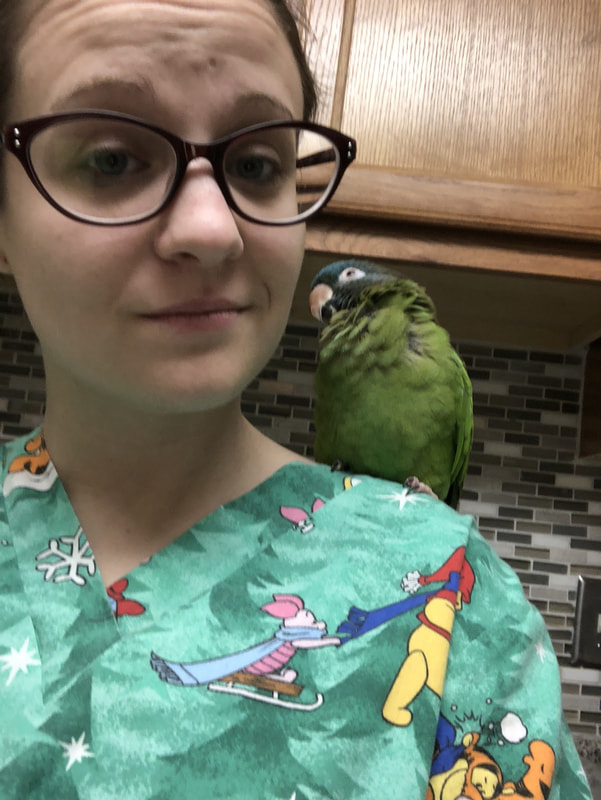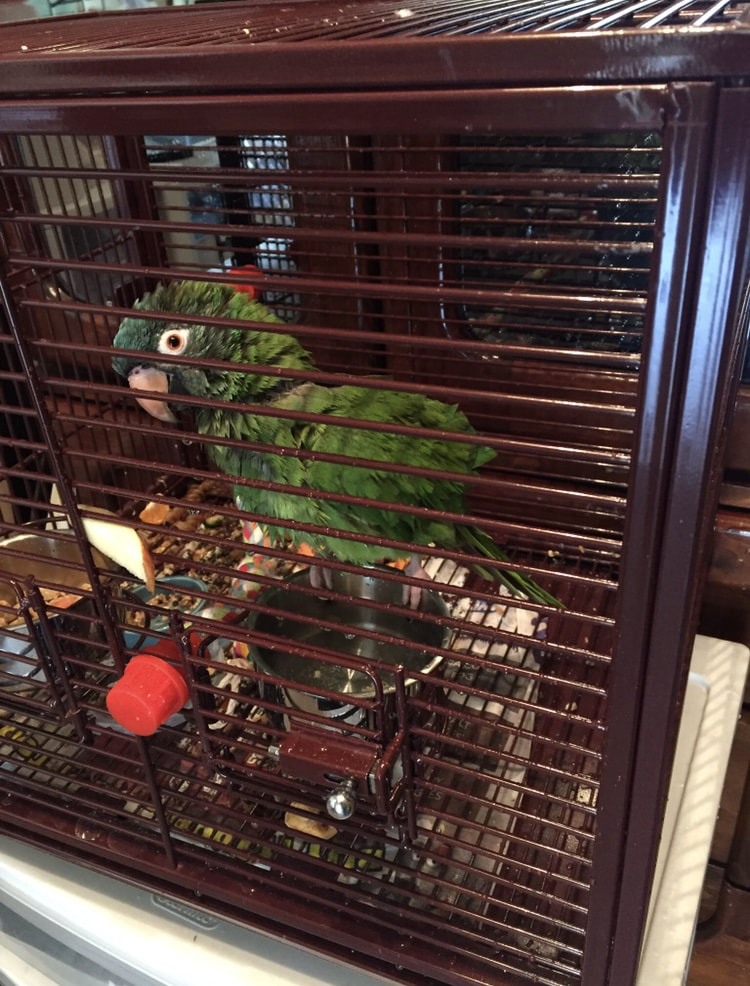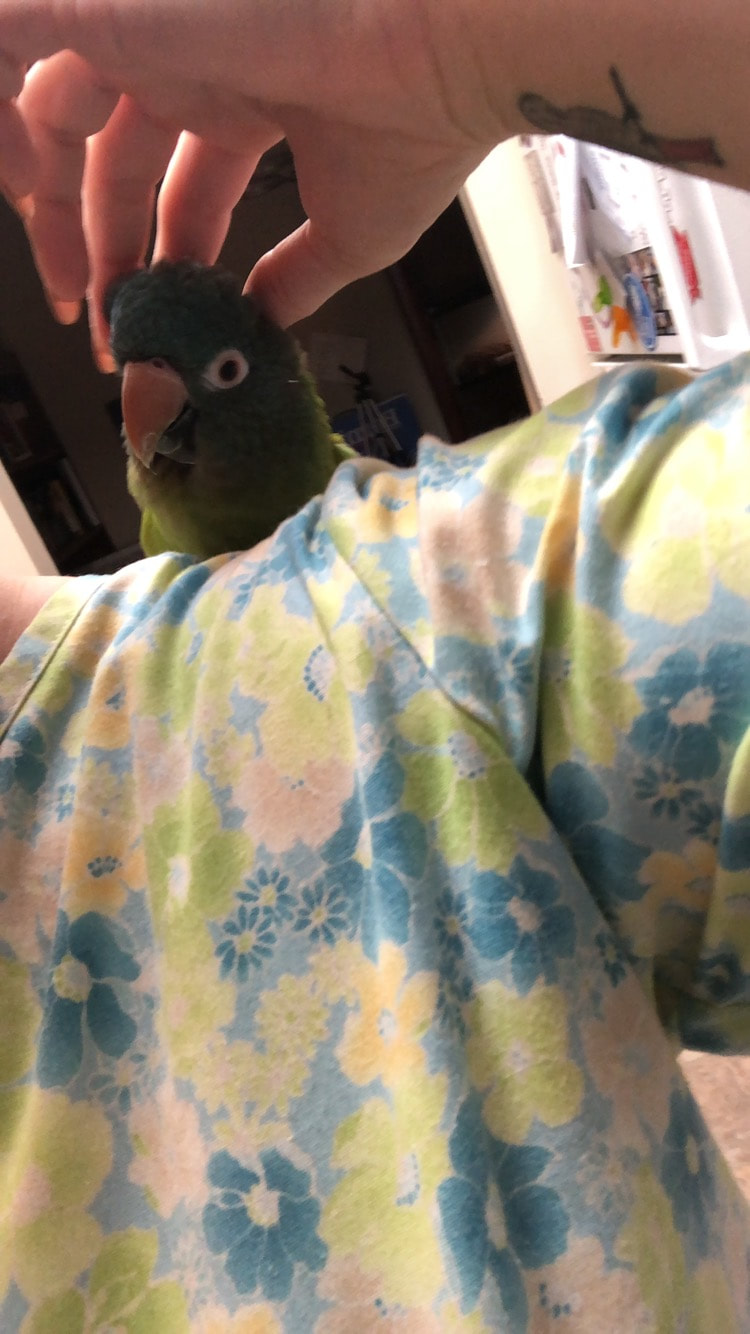|
As I write this, I’ve got a little green Frog sitting on my shoulder. Not just any little Frog though- this is a Froggie Bird. A Froggie bird that, a year ago today, would never have dreamed of perching on the shoulder of a human. (We are, quite obviously, Bird-Eating-Monsters you know.) But here we are, exactly one year later, quite bonded, and on much better terms. January is Adopt a Rescue Bird Month, and January 29th, 2017, I brought home my first rescue bird. After learning that this unidentified little green parrot was in need of a home, I went to a shelter in Baltimore County to meet it. The poor bird, who came in with the name “Topsy”, had come to the shelter with a friendly little green cheek conure, who quickly found a home. So alone, adrift from its previous life, this bird cowered in the corner of its cage. Two days before, its wings had been clipped rather roughly, removing any ability to fly with confidence. I could tell it was terrified. The shelter, as wonderful as those places are, was not familiar with birds. When I opened the cage door and stepped away, I saw visible relief from the bird, that hands were not coming to grab it. When I asked to hold it, they told me no- if the bird bit me, it would be “unadoptable”- we all know what that means. Bye-bye birdie. So, having never physically interacted with this somewhat bedraggled creature, I signed the papers to bring it home. Oh boy. What I got was a screaming, terrified mess. Hands were a BIG no-no. But, I signed up to love and care for you kiddo, and that’s what I’m gonna do. Below is my first picture of Froggie. She looks a little rough. Rescue birds, like any other rescued animal, require lots of extra patience. Froggie would scream, in her/his (we find out next month!) angry squeaky toy voice, for stretches of time that did not seem to ever end. When frightened, when hungry, when needing attention...screams. It takes some time to change screaming behavior. Patience. The first thing I knew I had to do, to accomplish anything with this bird, was to establish trust. I have no idea of this bird’s background. Whether it came from a loving home, its age, how it was treated...nothing. All I could do was reassure the bird that its future, with me, was going to be a good one. The key, I’ve found, was lots of research. There are numerous websites with lots of information on acclimating a bird to a new home (this blog will be expanding on it at later dates), training or applied behavioral analysis (fancy training terms!), and information specific to your type of bird. Ideally, you want to do the research first. Find out what treats your bird might like, safety hazards (such as Teflon and cleaning products), proper cage size, appropriate toys, dietary and sleep needs, and general behavior. I found Facebook groups very helpful for information and feedback. So I sat, and I talked to Froggie. I sat far enough away so as to not cause distress, and moved closer as her comfort level grew. I offered treats often, speaking to her gently, to build in her mind an association between me and good things happening to her. I cannot stress enough the importance of choice for birds- letting them decide to move closer, and letting them determine the pace. Her cage was and always will be, her safe place. I did not violate that by sticking my hand in it to get her out. She comes out on her terms. I asked nothing of Froggie, not a single “step up”, until she gained some confidence in her safety and our relationship. Eventually, she would accept a treat from me. Hurray for progress! However, she still lunged for any hand that came near...that was gonna take awhile. And take a while it did. But we made baby steps, compromises. She eventually grew comfortable enough to step up onto my arm, hand hidden inside a long sleeve. No skin, thank you very much! From there, she graduated to shoulder. After some time, I was able to get Froggie to step up onto my bare hand, as long as she was not on her cage when I asked. She’s still very territorial of it, as some birds are. I respect that boundary, and invite her to a perch or another cage before asking her to step up. Building that trust was imperative, because we had to have it to push her past her comfort zone. Once she trusted me, I was able to slowly start to desensitize her to hands being in her space. It’s important to do this at their pace, where the bird is maybe a little beyond comfort, but not stressed out. Once she realized that lunging at my fingers wasn’t going to make me pull away, she stopped doing it as much (she still tries to boss me when she thinks she can get away with it). Nowadays, Froggie is my velcro bird. If her cage door is open, she wants to be on my shoulder. (That’s the best place to help eat mom’s breakfast from!) She’s still not a big fan of hands, but as you can see, I can now give scritches! So, as an overview, please realize that all birds are individuals. The process of acclimating a new bird to your home could take days, weeks, months, years even. Research. Establish trust. Have patience…lots of patience. Let your bird determine the pace. Do some more research. Associate yourself with positive experiences for the bird. Talk to other bird owners, your vet, and your support network. Give the bird time to adjust and adapt. Birds are incredibly resilient, strong, intelligent creatures. By giving a rescue bird a home, and the time, attention, respect, and love it needs, you are giving them a second chance at life. And boy, do they deserve it. The tiny steps of progress you make will feel huge, when they show that tiny bit of trust. There’s no other feeling like it in the world. AuthorMiss Lina, one of the owners of Ferrets and Friends, is an enthusiastic advocate for feathered and scaly friends, wildlife, and animal rescue and rehabilitation. She currently works at a veterinary clinic to further her knowledge of animal care, and dedicates much of her time to learning more about animal behavior and cognition.
1 Comment
12/15/2023 10:43:32 pm
Wow! Your site is amazing. Please visit our website. Thanks
Reply
Leave a Reply. |
About the blogFerrets and Friends, LLC has four writers bringing you information on a variety of topics from pets to wildlife, education to conservation, and from new developments in our business to information about our industry. Learn something new each week! Archives
August 2020
Categories
All
|



 RSS Feed
RSS Feed